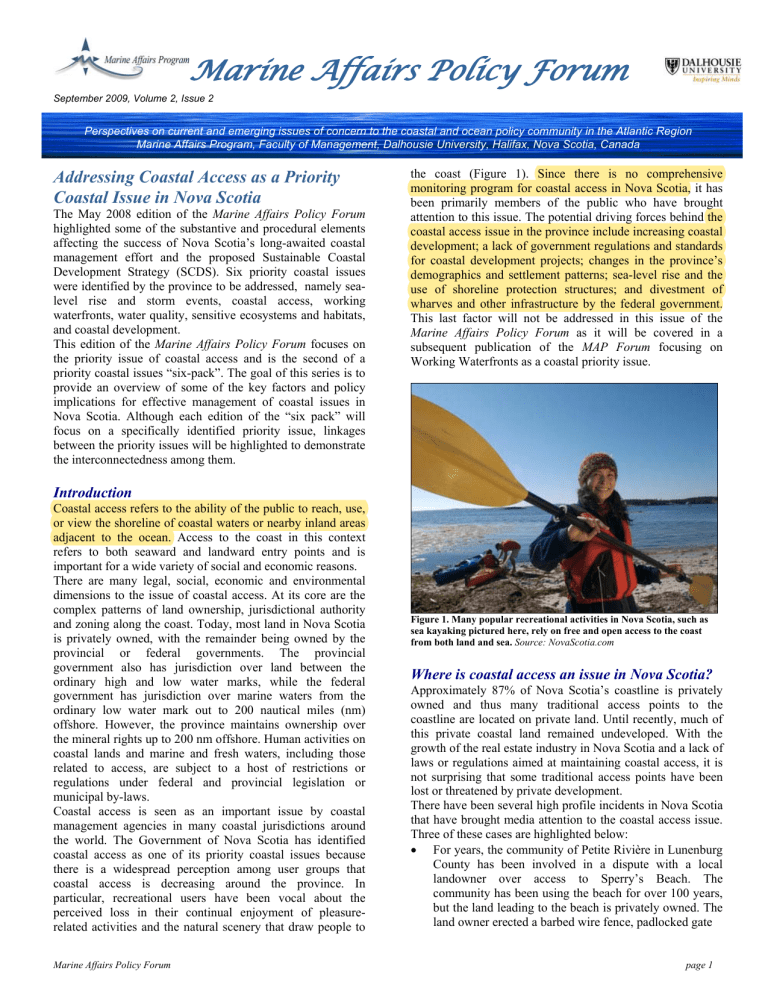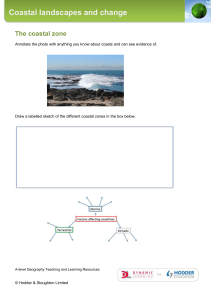
Marine Affairs Policy Forum September 2009, Volume 2, Issue 2 Perspectives on current and emerging issues of concern to the coastal and ocean policy community in the Atlantic Region Marine Affairs Program, Faculty of Management, Dalhousie University, Halifax, Nova Scotia, Canada Addressing Coastal Access as a Priority Coastal Issue in Nova Scotia The May 2008 edition of the Marine Affairs Policy Forum highlighted some of the substantive and procedural elements affecting the success of Nova Scotia’s long-awaited coastal management effort and the proposed Sustainable Coastal Development Strategy (SCDS). Six priority coastal issues were identified by the province to be addressed, namely sealevel rise and storm events, coastal access, working waterfronts, water quality, sensitive ecosystems and habitats, and coastal development. This edition of the Marine Affairs Policy Forum focuses on the priority issue of coastal access and is the second of a priority coastal issues “six-pack”. The goal of this series is to provide an overview of some of the key factors and policy implications for effective management of coastal issues in Nova Scotia. Although each edition of the “six pack” will focus on a specifically identified priority issue, linkages between the priority issues will be highlighted to demonstrate the interconnectedness among them. the coast (Figure 1). Since there is no comprehensive monitoring program for coastal access in Nova Scotia, it has been primarily members of the public who have brought attention to this issue. The potential driving forces behind the coastal access issue in the province include increasing coastal development; a lack of government regulations and standards for coastal development projects; changes in the province’s demographics and settlement patterns; sea-level rise and the use of shoreline protection structures; and divestment of wharves and other infrastructure by the federal government. This last factor will not be addressed in this issue of the Marine Affairs Policy Forum as it will be covered in a subsequent publication of the MAP Forum focusing on Working Waterfronts as a coastal priority issue. Introduction Coastal access refers to the ability of the public to reach, use, or view the shoreline of coastal waters or nearby inland areas adjacent to the ocean. Access to the coast in this context refers to both seaward and landward entry points and is important for a wide variety of social and economic reasons. There are many legal, social, economic and environmental dimensions to the issue of coastal access. At its core are the complex patterns of land ownership, jurisdictional authority and zoning along the coast. Today, most land in Nova Scotia is privately owned, with the remainder being owned by the provincial or federal governments. The provincial government also has jurisdiction over land between the ordinary high and low water marks, while the federal government has jurisdiction over marine waters from the ordinary low water mark out to 200 nautical miles (nm) offshore. However, the province maintains ownership over the mineral rights up to 200 nm offshore. Human activities on coastal lands and marine and fresh waters, including those related to access, are subject to a host of restrictions or regulations under federal and provincial legislation or municipal by-laws. Coastal access is seen as an important issue by coastal management agencies in many coastal jurisdictions around the world. The Government of Nova Scotia has identified coastal access as one of its priority coastal issues because there is a widespread perception among user groups that coastal access is decreasing around the province. In particular, recreational users have been vocal about the perceived loss in their continual enjoyment of pleasurerelated activities and the natural scenery that draw people to Marine Affairs Policy Forum Figure 1. Many popular recreational activities in Nova Scotia, such as sea kayaking pictured here, rely on free and open access to the coast from both land and sea. Source: NovaScotia.com Where is coastal access an issue in Nova Scotia? Approximately 87% of Nova Scotia’s coastline is privately owned and thus many traditional access points to the coastline are located on private land. Until recently, much of this private coastal land remained undeveloped. With the growth of the real estate industry in Nova Scotia and a lack of laws or regulations aimed at maintaining coastal access, it is not surprising that some traditional access points have been lost or threatened by private development. There have been several high profile incidents in Nova Scotia that have brought media attention to the coastal access issue. Three of these cases are highlighted below: For years, the community of Petite Rivière in Lunenburg County has been involved in a dispute with a local landowner over access to Sperry’s Beach. The community has been using the beach for over 100 years, but the land leading to the beach is privately owned. The land owner erected a barbed wire fence, padlocked gate page 1 and no trespassing signs, in an effort to deny local residents access to the property. People have found ways around and through the fence and have continued to access the beach. Members of the community have initiated a legal process to challenge the ownership of the land and re-establish unobstructed public access to the beach. The community of Cow Bay near Halifax has been another focal point of the coastal access issue. The area is home to several popular surf breaks. Access to one of these breaks, Silversands Beach or “The Moose” (named for the large concrete statue of a Moose located there), was threatened when developers sought to subdivide the property leading to the beach. A group of surfers formed the Coastal Access Committee and, along with a group of concerned residents known as Friends of the Moose, raised funds and lobbied the government to establish the Silversands Surfing Park in order to protect access to the beach (Figure 2). Access to several other surf breaks in the Cow Bay area have been lost or threatened by private development and the Coastal Access Committee continues to work towards restoring and maintaining public access to these breaks. Figure 2. The land leading to Silversands beach in Cow Bay has been designated as the Silversands Surfing Park; thus protecting access to the beach. Source: HalifaxNewsNet In 2007, a piece of provincial Crown land that included a beach near Big Harbour, Cape Breton was mistakenly sold, along with the land adjacent to the beach. The owners subsequently posted “No Trespassing” signs and prohibited local residents from accessing the beach. The provincial government has ordered an investigation into the land transfer. Who should be concerned and why? While all coastal stakeholders are either affected by or affect the issue of coastal access in one way or another, key interest groups associated with coastal access include coastal property owners, the public, the tourism industry, all levels of governments, the Mi’kmaq, environmental non-governmental organizations and commercial fishers. Coastal Property Owners: Since the vast majority of coastal land in Nova Scotia is privately owned, coastal property owners have a key role in the coastal access issue. Some private land owners, motivated by a desire for privacy or concerns over liability, will prohibit the public from Marine Affairs Policy Forum accessing the shoreline over their property. This can lead to a conflict between the landowner and the local community, particularly if the land was a traditional access point. Other private land owners have welcomed, and even encouraged, visitors to use and enjoy their property. Real Estate Industry: Historically, most coastal communities were established because marine-dependent activities such as fishing or boat building required access to the shoreline. Today, oceanfront property is in higher demand and more valuable than ever, but it is the desire for oceanfront homes and cottages that is the primary driver. Most coastal land in the U.S. has already been consumed by residential and commercial development and it is no surprise that many residents and non-residents alike are keen to own a piece of Nova Scotia’s largely undeveloped coastline. In some cases, these properties serve as traditional coastal access points for local residents, creating the potential for conflict as the property is developed and occupied. While realtors are not required to advise potential buyers of public expectations surrounding access, many do flag existing customary norms regarding traditional use over the property, but this advice does not require the owner to provide access. However, realtors are required to disclose any known rights-of-way to potential buyers as this provides for a legal requirement for access. The Public: The coast serves as the location for a variety of recreational activities popular among Nova Scotians including swimming, boating, kayaking, surfing, fishing, camping and hiking. Surveys conducted at provincial beaches in 1995 found that 33% of visitors visit the beach more than 10 times a year and the average length of stay was more than 4 hours. Thirty-seven percent of those surveyed swam in the ocean, while 89% walked along the beach or shoreline. A recent study in the United Kingdom (U.K.) suggests that coastal recreation can offer health benefits such as increased physical activity and reduced stress. Some recreational activities can be carried out in many different locations along the coastline, while others, such as surfing or kayaking, require access to particular locations along the coastline offering suitable conditions. Other recreationists may simply prefer to visit a particular location because of some personal value attached to it. Access to these locations may require crossing private land and many long-time users would be hesitant or unwilling to go elsewhere should private property owners suddenly prohibit access over their property. As coastal development increases throughout the province, Nova Scotians could potentially lose access to many of their preferred recreational sites. The Tourism Industry: Loss of access to areas of Nova Scotia’s coastline has the potential to severely impact the province’s tourism industry. Coastal tourism and recreation generates between $270 and 300 million in annual expenditures (excluding expenditures by local residents). The Nova Scotia Department of Tourism, Culture and Heritage identifies the province’s ‘beautiful seacoast and largely undeveloped natural environment’ as a strength upon which to build a sustainable tourism industry. However, an analysis of the strengths, weaknesses, opportunities and threats (SWOT analysis) of coastal tourism in Nova Scotia that was conducted by the provincial government and the tourism industry identified “decreasing access related to ownership of coastal property” as an industry weakness and “residents with waterfront property affecting access” as a threat. A market page 2 assessment of the marine tourism industry in Nova Scotia noted that access to coastal areas and public beaches is an increasing problem. Provincial Government: The provincial government has a variety of interests and responsibilities related to the coastal access issue. As noted earlier, the coastal tourism industry provides an important source of revenue and jobs for the province and maintaining coastal access is integral to its sustainability. The provincial government owns and administers less than 13% of the coastal land in the province. The government has protected 94 beaches under the Beaches Act as “significant and sensitive environmental and recreational resources.” The Department of Natural Resources maintains infrastructure on some protected beaches, such as boardwalks and trails that can facilitate coastal access (Figure 3). However, access to protected beaches is not guaranteed under the Act and accessing some beaches may require crossing private property. Furthermore, it may be necessary for the government to limit access and recreational activity on some beaches under the Act to protect their ecological integrity and avoid undesirable impacts on the beaches and associated dune systems. Ultimately, it will be the responsibility of the provincial government, working in collaboration with private property owners and other users of the coast, to find ways to resolve the growing conflict between those who demand public access to coastal areas and private land owners who demand that their private property rights be respected. Figure 3. Boardwalk providing access to the beach at Dominion Beach Provincial Park, Cape Breton. Source: Department of Natural Resources Municipal Government: Land-use planning is a responsibility of the municipal governments under the provincial Municipal Government Act and municipal politicians are often drawn into disputes over coastal access within their riding. The Act requires a minimum of 5% of the oceanfront land in a subdivision with frontage on the ocean be transferred to the municipality as public parks for the purpose of providing public access to the ocean. The Halifax Regional Municipality has increased the minimum requirement in their jurisdiction to 10% under their municipal planning strategy. By including coastal access considerations in municipal land-use strategies and by-laws, traditional access points can be protected, thereby minimizing conflicts over access in coastal communities. Federal Government: Although the vast majority of coastal land in the province belongs to private owners or the provincial government, various federal government agencies control a small percentage of coastal land in the province. Marine Affairs Policy Forum Due to security concerns, public access to much of this property is prohibited. However, the Department of Fisheries and Oceans (Small Craft Harbours) and Transport Canada own or administer ports, harbours, wharves and other facilities that serve as access points for recreational activities as well as commercial enterprises in fisheries, tourism and recreation. The Mi’kmaq: All of Nova Scotia is traditional territory of the Mi’kmaq and their ancestors, who, for thousands of years, hunted and fished in coastal areas of the province. However, European colonization of Canada has resulted in loss of access for the Mi’kmaq to much of their territory. In 2007, the Mi’kmaq and the governments of Nova Scotia and Canada signed the Mi’kmaq of Nova Scotia Framework Agreement for the Made-in-Nova Scotia Process. This framework agreement is a preliminary step in resolving Mi’kmaq rights issues in Nova Scotia including land claims and other interim ways to protect some areas of critical importance to the Mi’kmaq. As such, the potential for decisions arising from this agreement to affect coastal access must be taken into consideration. Environmental Non-Governmental Organizations (ENGOs): Although coastal access can have many positive social and economic effects, coastal access can also negatively impact coastal ecosystems and habitats. Local (e.g. Kingsburg Coastal Conservancy), provincial (e.g. Ecology Action Centre) and national (e.g. Canadian Parks and Wilderness Society) ENGOs have been instrumental in highlighting the threats to Nova Scotia’s coastal ecosystems and habitats posed by human activity. Coastal features such as beaches and wetlands are among the most popular coastal recreation areas, but these biophysical features serve as important ecosystems and habitats to a wide variety of wildlife species. Coastal ecosystems and habitats can be extremely sensitive to human activities and disturbance. For example, many beaches along the Atlantic coast, popular among tourists and recreationists, also serve as critical nesting habitat for the endangered piping plover (Charadrius melodus melodus). The loss of piping plover habitat, mostly caused by human use of beaches and human disturbance around nesting sites, has been identified as the primary threat to the species. Human activity on beaches has also been associated with the loss of stabilizing vegetation on sand dunes, making the dunes more vulnerable to storm damage and erosion. Efforts to prevent or mitigate the negative impacts of human activity on sensitive coastal ecosystems and habitats in Nova Scotia have included building boardwalks over dunes and marshes, using signs to notify the public about sensitive wildlife habitat and protecting ecologically sensitive beaches under provincial legislation. Commercial Fishers: Access to the shoreline and coastal waters is an obvious necessity for commercial fishers and the loss of any landing site can have a negative economic impact on this industry, particularly on the livelihoods of inshore fishers. For example, clam harvesters in the Annapolis Basin are concerned over a growing trend towards privatization of clam beaches. The provincial government has begun issuing aquaculture leases to private companies on clam beaches that have been closed to harvesting because of contamination. As a result, clam harvesters are denied access to their traditional harvesting areas unless they go to work for the private companies. page 3 Policy Implications The current pattern of coastal development in the province suggests many Nova Scotians stand to lose access to the coast. The benefits of coastal access are difficult to express in economic terms, creating a tendency for short-term economic benefits for a few (e.g. real estate development) to triumph over the substantial social and economic benefits coastal access provide to a larger number of Nova Scotians. As illustrated by the examples above, failure to resolve this issue will result in a growing number of conflicts between private land owners and other user groups. Loss of coastal access is an issue faced by coastal jurisdictions around the world. Incorporating the principle of the public trust doctrine, which gives citizens certain rights to the coastal environment, some nations have established laws that guarantee public access to the coast. For example, section 303 of the U.S. Coastal Zone Management Act of 1972 calls on states to create coastal management programs that, among other things, provide for public access to the coast for recreational purposes. As a result, many states have developed a variety of tools and approaches to address coastal access. Texas, California and Washington have passed laws declaring public rights to access the shoreline. Under the proposed Marine and Coastal Access Bill, the U.K. is looking to establish a pedestrian route along the entire length of that country’s coast that includes a margin of land along the shoreline accessible to the public for their enjoyment. A surprising number of community organizations and NGOs have been established in Nova Scotia specifically to address the increasing conflicts over coastal access. This illustrates the urgency of this issue and the apparent lack of patience among many Nova Scotians for a provincial coastal management strategy to address their concerns. Examples include the Kingsburg Coastal Conservancy, the Kingsburg Beach Action Committee, the Coastal Access Committee, Friends of the Moose, Friends of Crescent Beach, and the Sperry’s Beach Committee. In May of this year, the Coastal Nova series, sponsored by the Marine Affairs Program (MAP) at Dalhousie University, St. Mary’s University, the Ecology Action Centre and the Coastal Coalition of Nova Scotia, organized a workshop to explore various perspectives of the coastal access issue including public access rights, private property rights and the sensitivity of coastal ecosystems to human impacts. The workshop was attended by participants from 24 different organizations ranging from community groups, NGOs, all levels of government, academic institutions and industry; demonstrating the desire of all Nova Scotians to share information and work collectively to find solutions to the coastal access issue. Participants identified key issues related to coastal access in Nova Scotia and offered a series of recommendations aimed at addressing these issues.* Likewise, the MAP-sponsored expert workshop on defining the coast in June 2008 identified human uses and settlement pattern, along with ecological considerations, as critical criteria to guide policy-setting regarding coastal access. Nova Scotia’s newly elected government has already committed to establishing legislation aimed at protecting public access in the province. The government has promised to create a community lands trust that will be mandated by law to identify, acquire and protect land in order to maintain traditional community and public access points. The community lands trust is a promising mechanism for Marine Affairs Policy Forum communities to maintain access to coastal lands; however, it is likely that more than 80% of coastal lands will remain private. Protecting public access in the province must therefore involve creating incentives for private land owners to allow the public to access their land, while at the same time, ensuring the land is used responsibly and respectfully. Property owners also need to be assured of protection from nuisance claims regarding liability. Nova Scotia is not the only jurisdiction faced with the challenge of maintaining public access over large areas of privately owned coastal land. Other jurisdictions have successfully employed a number of management tools to address this problem, including permit reviews, conservation easements, zoning, tax incentives, liability limitations and education campaigns. For example, under the Connecticut Coastal Management Act, shoreline development in that state must address coastal access opportunities as a condition of municipal development permits. In Massachusetts, the government has made available a free coastal access handbook as a means of providing technical assistance to help communities reclaim rights-of-way to the sea and has developed an online guide that provides information and maps to help people visit the shoreline. The government of Maine has also issued a series of guidebooks on coastal access that deal with topics such as community-based access inventories, legal and liability issues for private landowners, public access plans and rediscovery of public rights-of-way. Private development is not the only threat to coastal access in Nova Scotia. Coastal hazards threaten roads, boardwalks, trails and other structures that support access to the coast. Sea-level rise and erosion cause the shoreline to migrate inland, reducing the area of land available to the public between the shoreline and development. Engineered structures designed to protect property from coastal hazards, such as seawalls and riprap, can block access to portions of the shoreline. Last fall, post-tropical storm Noel destroyed the access road to Queensland Beach in Halifax County. The road has since been repaired, but some residents have complained that large boulders that now line the beach to protect it from future storm damage limit access to beach at high tide and will actually increase erosion rates at the beach. Concluding Comments The continued development of Nova Scotia’s coastline will most certainly lead to a growing number of conflicts over coastal access among user groups. Fortunately, much of the province’s coastline remains open and accessible to the public and there is an opportunity, through the Sustainable Coastal Development Strategy, for the provincial government to minimize the conflict over coastal access and ensure future generations of residents and visitors can freely access the coast for their enjoyment and continued livelihood. This will involve engaging private land owners, acquiring coastal lands for public use, building public awareness of the issue and incorporating coastal access concerns in land-use planning. ________________________________________________ *The workshop report and summary, including the key issues and list of recommendations is available at: http://marineaffairsprogram.dal.ca/News_and_Events/ This document is based on research undertaken by Christopher Burbidge and Lucia M. Fanning at the Marine Affairs Program, Dalhousie University. To enhance readability, references are not included but are available upon request to marine.affairs@dal.ca page 4





